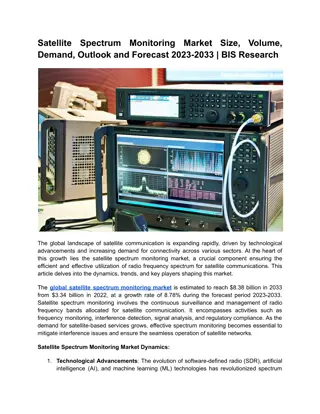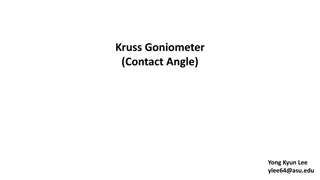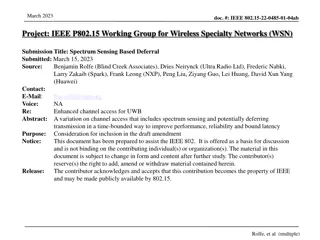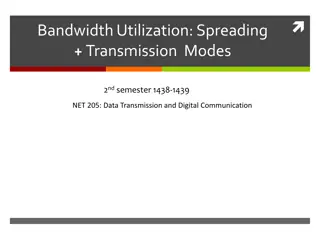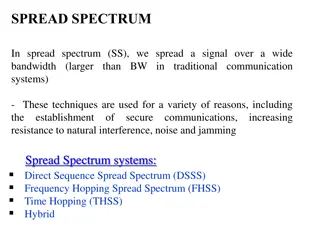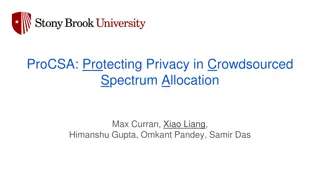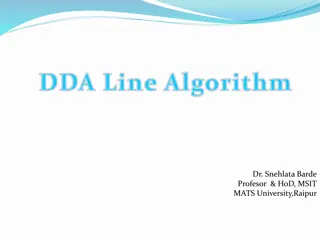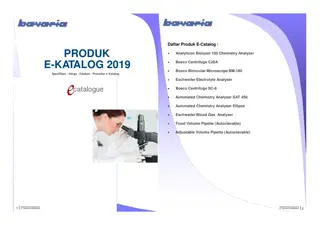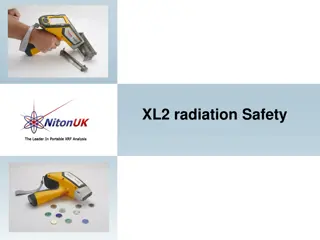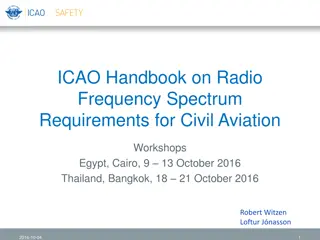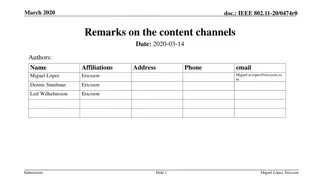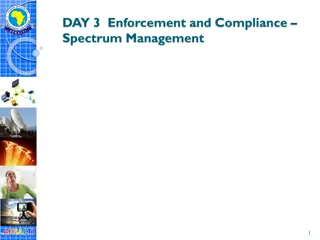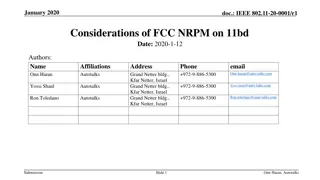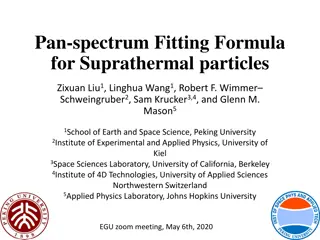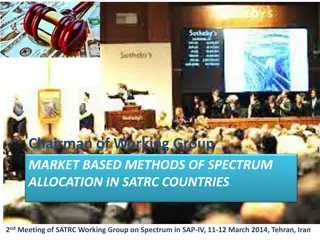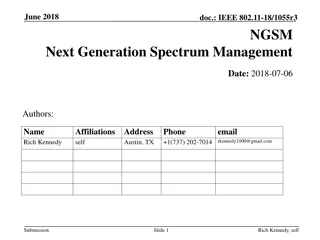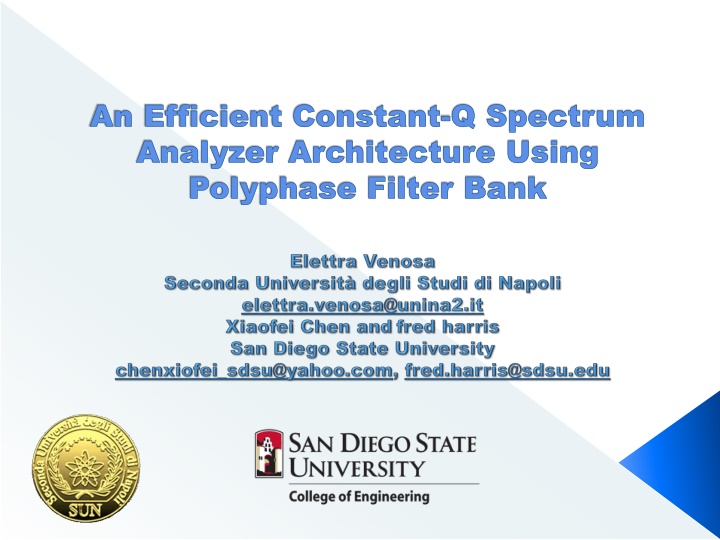
Efficient Constant-Q Spectrum Analyzer Architecture
This article delves into an efficient constant-Q spectrum analyzer architecture using a polyphase filter bank developed by SDSU College of Engineering. The constant-Q filter bank, with bandwidths proportional to center frequencies and spectra equally spaced on a log scale, is explained along with the benefits of using a constant-Q spectrum analyzer. The conventional structure is discussed, and the goal is to decrease workload through a polyphase M-to-2 down converter channelizer. The polyphase M-to-1 down converter channelizer process is also outlined in detail.
Download Presentation

Please find below an Image/Link to download the presentation.
The content on the website is provided AS IS for your information and personal use only. It may not be sold, licensed, or shared on other websites without obtaining consent from the author. If you encounter any issues during the download, it is possible that the publisher has removed the file from their server.
You are allowed to download the files provided on this website for personal or commercial use, subject to the condition that they are used lawfully. All files are the property of their respective owners.
The content on the website is provided AS IS for your information and personal use only. It may not be sold, licensed, or shared on other websites without obtaining consent from the author.
E N D
Presentation Transcript
An Efficient Constant-Q Spectrum Analyzer Architecture Using Polyphase Filter Bank SDSU College of Engineering
Constant-Q Filter Bank The filter bandwidths are proportional to their center frequencies The ratio of a filter s center frequency to its bandwidth is called Q The filter spectra are equally spaced and have equal bandwidths on a log scale! Frequency Response of 6-Propotional Bandwidth Filters from 0.125 to 0.25 0 -20 Magnitude (dB) -40 -60 -80 0 0.05 0.1 0.15 0.2 Normalized Frequency (0 to 0.5) 0.25 0.3 0.35 0.4 0.45 0.5
Constant-Q Spectrum Analyzer Why we should use Constant-Q Spectrum Analyzer? It matches the model of the human ear and of mechanical resonators! Some applications: Acoustic Speech Vibration analysis For spectrum analyzers that process communication systems, a bank of equally spaced center frequencies and equal bandwidth narrowband filters spanning the frequency range of interest is used
Conventional Structure Shift the frequency band occupying the next lowest octave to the spectral interval of the top octave simultaneously sample rate Half-Band Filter + 2:1 Down Sampler reducing its Decomposes the selected spectrum by using a proportional bandwidth filter bank Octave Processor
Our Goal We want to decrease the workload of the conventional spectrum analyzer Decreasing the sample rate of the octaves before processing them Polyphase M-to-2 down converter channelizer
Polyphase M-to-1 Down Converter Channelizer Let start from the beginning ..
Polyphase M-to-1 Down Converter Channelizer and then generalize simultaneously down converts and down samples M equally spaced, fixed bandwidth signals. It simultaneously down converts and down samples M equally spaced, fixed bandwidth signals
Polyphase M-to-2 Down Converter Channelizer 0 1 0 1 N-P ath Input Data Buffer Circular Output Buffer N-P ath P olyphase Filter 2 2 .... 3 .... .... .... .... .... .... N-P oint IFFT .... .... N/2-1 N/2 N/2+ 1 N N N N . N-2 N-1 N-1 State Engine Input Data Buffer Correct Data Loading Circular Output Buffer Phase Alignment
Proposed Spectrum Analyzer Second output: to the octave processor First output: to the next stage Proportional bandwidth filter bank M:2 down converter channelizer
Frequency Domain Vision First 4:2 Down Converter Output ([1/8, 1/4]) Second 4:2 Down Converter Output ([-1/4, 0]) 135 Shift Real Part We need to further process the signal before delivering it to the proportional bandwidth filter bank
Simulation Results: Constant-Q Filter Bank Frequency Response of 6-Propotional Bandwidth Filters Translated to 0.125 to 0.375 10 0 -10 -20 Magnitude (dB) -30 -40 -50 -60 -70 -80 0 0.05 0.1 0.15 0.2 0.25 0.3 0.35 0.4 0.45 0.5 Normalized Frequency 9thorder recursive filters designed by using all-pass networks
Simulation Results: Four Stages Spectrum Analyzer Frequency Response of 6-Proportional Filters per Octave in Four Successive Stages Frequency Response of Channel 0 for Four Stages 0 10 Magnitude (dB) -20 0 -40 -10 -20 -60 Magnitude (dB) -30 -80 -20 -18 -16 -14 -12 -10 -8 -6 -4 -40 Normalized Frequency (Log Scale) -50 Frequency Response of 6-Proportional Filters per Octave in Four Successive Stages 0 -60 Magnitude (dB) -20 -70 -40 -80 0 0.05 0.1 0.15 0.2 0.25 0.3 0.35 0.4 0.45 0.5 -60 Normalized Frequency -80 0 0.05 0.1 0.15 0.2 0.25 0.3 Frequency responses for the 4- path down converter (channel 0) for four successive stages Normalized Frequency (Linear Scale) Frequency responses for a complete four stages constant-Q spectrum analyzer
Workload Analysis The workload for an arbitrary large number of stages is always less than twice the workload of the first stage (L) Ops Input L 2 L 4 L 8 <L+ + + + <2L First Stage Workload Analysis: Low-pass prototype filter (4:2 down sampler): 79 multiplies (3 /4) frequency shifting: 4 multiplies Proportional filter bank:18 multiplies per filter (108 multiplies) Ops Input 1 2 1 4 1 8 . ( ) <955 1+ + + + <191
Conclusions We presented the design process and the sample spectrum responses of a novel, extremely efficient, constant-Q spectrum analyzer We used recursive filters to obtain six proportional bandwidth filters to span an octave with a reasonable computational workload The proposed structure uses only a 4-path down converter polyphase channelizer and a bank of constant-Q filters The process can be extended to implement any number of filters per octave and any number of stages
Now we are Open for Questions!

